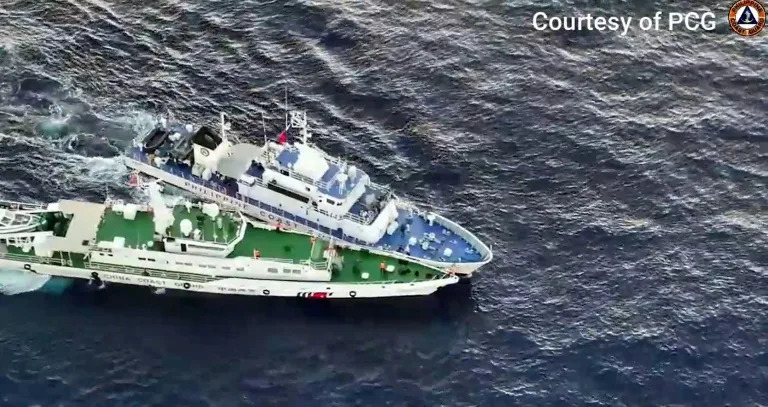The Philippine Coast Guard said one of its ships was damaged Tuesday in a collision with a China Coast Guard vessel during a resupply mission to Filipino troops on a remote outpost in the South China Sea.
A frame grab from aerial video footage shows the collision between ships of the Chinese and Philippine coast guards.
It is the latest incident in waters around Second Thomas Shoal in the Spratly Islands where the countries have contesting maritime claims.
Chinese coast guard and other vessels undertook "dangerous manoeuvres and blocking", leading to a collision that resulted in "minor structural damage to the PCG (Philippine Coast Guard) vessel," Philippine Coast Guard Commodore Jay Tarriela said in a post on social media platform X.
The BRP Sindangan, along with a sister ship, had been deployed "to support" a military rotation and resupply mission to Second Thomas Shoal, where Filipino troops are stationed on a grounded Philippine navy vessel.
China's coast guard said it "took control measures" against Philippines ships' "illegal intrusion" in waters around Ren'ai Reef in China's Nansha Islands," using the Chinese names for the shoal.
China claims almost the entire South China Sea, brushing aside competing claims from a host of Southeast Asian nations and an international ruling that declared its stance baseless.
The incident comes a day after Philippine Foreign Minister Enrique Manalo called on China to "stop harassing us" as he defended Manila's strategy of publicising Chinese manoeuvres in the South China Sea.
Philippine President Ferdinand Marcos was similarly forthright when he appeared later Monday evening at an event hosted by an Australian think tank.
"We shall never surrender even a square inch of our territory and our maritime jurisdiction," he said on the sidelines of the ASEAN summit in Melbourne.
The collision was the second such incident since December, when Chinese ships blasted water cannon at Philippine boats.
Those confrontations were the most intense between Philippine and Chinese vessels in years, analysts said at the time, predicting that there would be an escalation in tensions.
Relations between Manila and Beijing have frayed under Marcos, who has sought to improve ties with traditional ally Washington and deepen defence cooperation in the region, while also pushing back against Chinese actions in the South China Sea.
That contrasts with the approach of former president Rodrigo Duterte, who set aside maritime disputes with Beijing in exchange for promises of Chinese investment.
Manipulated images do not show US-China maritime 'clash'
YouTube videos viewed tens of thousands of times in the Philippines do not show a military confrontation between the United States and China in the South China Sea, a hotly contested waterway that has long been a source of tension in Asia Pacific. The videos included compilations of old warship photos -- some of which were manipulated -- and there have been no official reports of a US-China spat.
"US Coast Guard aggressively confronts a Chinese warship circling near Ayungin," reads the title of a YouTube video posted on February 7, 2024.
Ayungin is the Philippine name for the Second Thomas Shoal in the Spratly Islands, which is a flashpoint for Manila and Beijing.
Second Thomas Shoal is about 200 kilometres (120 miles) from the Philippine island of Palawan and more than 1,000 kilometres (620 miles) from China's nearest major landmass, Hainan island.
The eight-minute video -- which included various photos of warships -- displayed a thumbnail of two ships appearing to approach each other.
In the clip, a man narrating the video says the United States "sought revenge" against the Chinese navy by tailing its warship during a patrol of the South China Sea.
"While they were conducting a freedom-of-navigation operation in the South China Sea, the US Navy identified a warship from the People's Liberation Army Navy and decided to follow them," he says in Tagalog.

China claims almost the entire South China Sea and has ignored an international tribunal ruling that its assertions have no legal basis.
Tense standoffs between Manila and Beijing over the waterway have flared in recent months following spats between Philippine and Chinese vessels, including several collisions.
Washington, which has a mutual defence pact with Manila, has denounced aggressive Chinese actions towards its ally and vowed to keep open the South China Sea, through which trillions of dollars worth of trade is shipped every year.
Fictional 'confrontation'
The same YouTube channel shared another video of a purported confrontation between Chinese and US ships on February 16, 2024.
It claimed the incident happened in the West Philippine Sea, the term Manila uses for the South China Sea waters immediately west of the Philippines.
The narration claimed British, Canadian and Australian diplomats reacted to the incident by denouncing China's "dangerous maneuvers against Philippine vessels."
The video's thumbnail -- supposedly showing a stand-off between two US ships and a Chinese vessel -- can be seen below:

The videos surfaced after the United States and the Philippines held their third joint sea and air patrol in three months off the Southeast Asian country's coast.
While the YouTube videos contained a disclaimer that they were created "purely for entertainment purposes", many social media users appeared to believe they showed genuine news reports.
"Good job, US Navy!" one comment read.
"It's a big help to us, to our Phil Navy…thank you Big Brother America," another wrote.
However, reverse image searches on Google, Bing and Yandex revealed the various clips in the YouTube videos were manipulated or misrepresented.
Misrepresented images
The first video's thumbnail shows a US Navy frigate and a US Coast Guard ship in the Java Sea -- not a Chinese warship in the South China Sea.
The original photo -- published by UK-based media outlet Alamy -- was taken on May 30, 2010 (archived link).
The photo's caption reads: "USS Vandegrift (FFG 48) and U.S. Coast Guard Cutter Mellon (WHEC 717) move into position prior to commencing a surface gunnery exercise as part of Naval Engagement Activity (NEA) Indonesia 2010."
Below is a screenshot comparison of the photo shared in false YouTube videos (left) and by Alamy (right):

The photos presented when the video's narration describes a "US Navy vessel tailing a Chinese warship" actually show US and British ships -- not US and Chinese vessels.
The photo at the 27-second mark shows a US Navy destroyer and a Royal Navy frigate during a 2019 military exercise in the South China Sea (archived link).
The succeeding image at the clip's 47-second mark -- when the narrator describes a US freedom-of-navigation operation in the South China Sea -- in fact shows a US vessel in the Atlantic Ocean in 2011 (archived link).
There have been no official reports about a US military freedom-of-navigation operation in the South China Sea in February 2024.
The latest such operation took place in November 2023 near the Paracel Islands, which are claimed by China, Vietnam and Taiwan (archived link).
False context
The rest of the footage describes a Chinese ship maneuvering in an unsafe manner near an American destroyer in the Taiwan Strait.
This incident was widely reported in June 2023 -- not in 2024 as the false YouTube video claimed (archived link).
The second video's thumbnail shows two unrelated images: one of US ships taking part in military exercises between America and Australia in 2019; and another Reuters photo of a China Coast Guard vessel in 2017 was digitally inserted into the post.
Below are screenshot comparisons of the photo shared in false YouTube videos (left) and the original photos (right):


AFP has previously debunked videos showing fabricated standoffs in the South China Sea.



